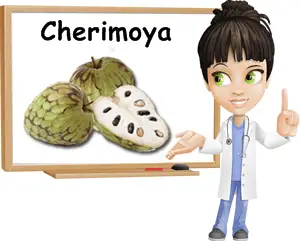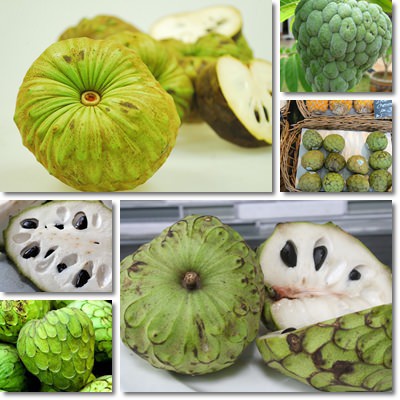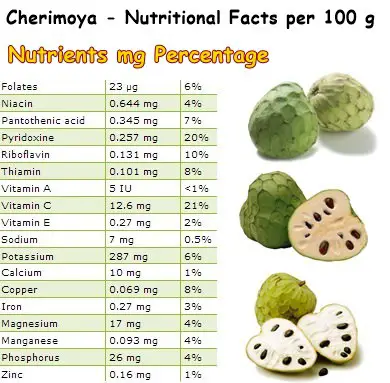Chirimoya, cherimoya, chirimoyo or ‘custard apple’ is the exotic fruit of the cherimoya (Annona cherimola) tree. The fruit is cultivated extensively in Central and South America, Tanzania, Egypt, Italy, India, Thailand and Singapore.
Cherimoya is a good source of vitamins C and B6 and contains small amounts of important minerals such as copper, potassium, magnesium, manganese, phosphorus and iron which give it tonic properties and an invigorating effect.
Being a good source of fiber, this fragrant fruit boasts cholesterol-lowering properties and promotes cardiovascular health.
Cherimoya is not only low in calories, but also has an extremely low fat content, as well as a high water content. Regular consumption promotes weight loss naturally, helps regulate digestion, boost immunity and manage anemia caused by iron deficiency.
Moreover, the fruit contains elements with antioxidant, anti-aging and anti-inflammatory properties and benefits bone health.

What does cherimoya (custard apple) look like?
Cherimoya is either a roundish apple shaped or heart-shaped fruit with light green skin, covered in bumps that I find look very similar to scales. While some varieties have a softer skin, others have more prominent, almost pointy bumps. Although some varieties can reach a few kilos, usually only medium-sized 300-400 g fruit are marketed (cherimoya are quite pricey outside their production areas). Ripe cherimoya are green or yellow-green and have a creamy-white, soft-textured, somewhat mushy or custard-like pulp. Cherimoya seeds are hard, shiny, dark brown-colored and evenly spread throughout the pulp. Neither the seeds, nor the skin are edible.
What does cherimoya taste like and why is it called ‘custard apple’?
Well ripe, fresh cherimoya fruit are quite fragrant and kind of sweet. The reason why they are called ‘custard apple’ is that they have a custard-textured pulp which taste somewhat like custard. Cherimoya tastes something between vanilla and banana, with a mushy pear-pulp texture, occasionally gritty, but a good kind of gritty. The fruit also has a particular sweet fragrance that reminds me of peaches or pineapple.
How to choose good, ripe cherimoya
Choose the largest green, slightly yellow-green cherimoya and avoid the fruit with brown spots because they may be well past their season. Ripe cherimoya has a soft, ready to crack skin. If the fruit is hard, leave it to soften (a.k.a. ripe) for a few days at room temperature. Remember to also give it a sniff: if it gives off a pleasant, fragrant smell, then it should be good to eat.
What happens if you put cherimoya in the refrigerator?
The same thing that happens with bananas: their skin gets damaged by the cold and turns brown, but they are still good on the inside. If your cherimoya lacks flavor, if it tastes bland, like a flavorless custard, then it might be overripe.

Cherimoya benefits and uses
Cherimoya has about 70 kcal/ 100 g of raw pulp. Not only this, but it is 79.39% water and only 0.68% fat. What this basically means is that cherimoya can help you lose weight and keep you hydrated, provided you replace some of the unhealthier foods in your diet with 1-2 helpings of the fruit. If you find this fruit to you liking and want to change the way you eat it, you can juice it, add it to smoothies, even ice cream.
Because it contains no saturated fats and no cholesterol and provides 3 g of fiber/100 g of pulp, cherimoya is a safe food for anyone struggling with high cholesterol levels or battling cardiovascular disease. Dietary fiber, for instance, prevents fat from food from being absorbed by the intestines, thus indirectly contributing to lowering cholesterol levels. Increasing your fiber intake also adds bulk to stools and makes them softer and thus easier to pass. This translates into improved intestinal motility and constipation relief as well as promotes colon health and helps manage hemorrhoids symptoms.

Cherimoya was found to contain several antioxidants called acetogenins. According to preliminary research, these compounds have anti-malaria, anthelminthic (killing intestinal parasites) as well as anticancer properties which may prove useful for the development of future treatments.
Nevertheless, a study suggests that the same antioxidant acetogenins, when consumed in excess, may cause damage to nerve cells, possibly resulting in symptoms similar to Parkinson’s syndrome: instability, tremors, shaking and other movement problems. However, it has yet to be proven that a moderate consumption of cherimoya may cause any health issues.
As you can see from the nutrition table above, cherimoya is a good source of vitamin C, providing 20% of RDA. Vitamin C stimulates the production of collagen, a protein that maintains the structure of our skin, blood vessels, organs and bones. Basically, a good vitamin C intake stimulates our body to produce enough collagen to keep us looking young and wrinkle-free.
In addition to this, vitamin C prevents scurvy, helps strengthen the immune system against viral infections, accelerates wound healing and protects cells and DNA against free radical damage. Introducing foods rich in vitamin C or supplementing to meet our daily requirements is important for good health and general wellbeing.
Cherimoya contains good amounts of pyridoxine (vitamin B6) and riboflavin (vitamin B2), thiamine (vitamin B1) and pantothenic acid (vitamin B5). B complex vitamins supports the activity of the nervous, digestive, muscular and respiratory systems. Last but not least, the fruit boasts small amounts of important minerals such as copper, potassium, magnesium, manganese, phosphorus and iron, which protect against oxidative stress, boast anti-aging and blood pressure-lowering effects, contribute to hormonal balance, bone health and anemia prevention and management.
Conclusion
Overall, cherimoya is a healthy choice, worth including in our diets. Considering its nutritional profile, the fruit contributes to good digestion and good energy levels, supports nervous system function and boosts immunity. The fact that is has a soft texture and a sweet, fragrant taste with fruity flavors makes it even more appetizing and more of a reason to include it into your diet.
